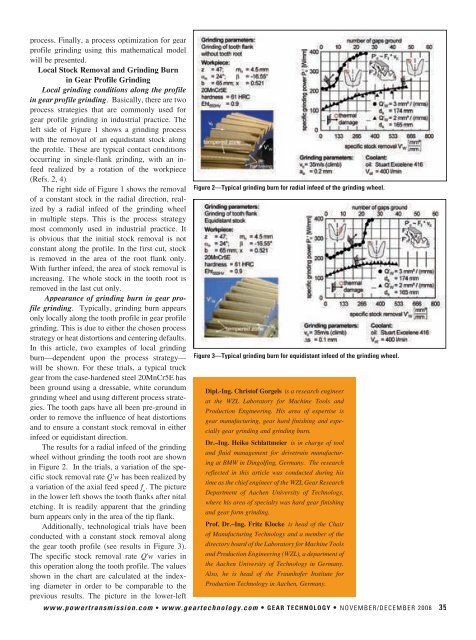Download - Gear Technology magazine
Download - Gear Technology magazine
Download - Gear Technology magazine
Create successful ePaper yourself
Turn your PDF publications into a flip-book with our unique Google optimized e-Paper software.
process. Finally, a process optimization for gear<br />
profile grinding using this mathematical model<br />
will be presented.<br />
Local Stock Removal and Grinding Burn<br />
in <strong>Gear</strong> Profile Grinding<br />
Local grinding conditions along the profile<br />
in gear profile grinding. Basically, there are two<br />
process strategies that are commonly used for<br />
gear profile grinding in industrial practice. The<br />
left side of Figure 1 shows a grinding process<br />
with the removal of an equidistant stock along<br />
the profile. These are typical contact conditions<br />
occurring in single-flank grinding, with an infeed<br />
realized by a rotation of the workpiece<br />
(Refs. 2, 4).<br />
The right side of Figure 1 shows the removal<br />
of a constant stock in the radial direction, realized<br />
by a radial infeed of the grinding wheel<br />
in multiple steps. This is the process strategy<br />
most commonly used in industrial practice. It<br />
is obvious that the initial stock removal is not<br />
constant along the profile. In the first cut, stock<br />
is removed in the area of the root flank only.<br />
With further infeed, the area of stock removal is<br />
increasing. The whole stock in the tooth root is<br />
removed in the last cut only.<br />
Appearance of grinding burn in gear profile<br />
grinding. Typically, grinding burn appears<br />
only locally along the tooth profile in gear profile<br />
grinding. This is due to either the chosen process<br />
strategy or heat distortions and centering defaults.<br />
In this article, two examples of local grinding<br />
burn—dependent upon the process strategy—<br />
will be shown. For these trials, a typical truck<br />
gear from the case-hardened steel 20MnCr5E has<br />
been ground using a dressable, white corundum<br />
grinding wheel and using different process strategies.<br />
The tooth gaps have all been pre-ground in<br />
order to remove the influence of heat distortions<br />
and to ensure a constant stock removal in either<br />
infeed or equidistant direction.<br />
The results for a radial infeed of the grinding<br />
wheel without grinding the tooth root are shown<br />
in Figure 2. In the trials, a variation of the specific<br />
stock removal rate Q'w has been realized by<br />
a variation of the axial feed speed f a<br />
. The picture<br />
in the lower left shows the tooth flanks after nital<br />
etching. It is readily apparent that the grinding<br />
burn appears only in the area of the tip flank.<br />
Additionally, technological trials have been<br />
conducted with a constant stock removal along<br />
the gear tooth profile (see results in Figure 3).<br />
The specific stock removal rate Q'w varies in<br />
this operation along the tooth profile. The values<br />
shown in the chart are calculated at the indexing<br />
diameter in order to be comparable to the<br />
previous results. The picture in the lower-left<br />
Figure 2—Typical grinding burn for radial infeed of the grinding wheel.<br />
Figure 3—Typical grinding burn for equidistant infeed of the grinding wheel.<br />
Dipl.-Ing. Christof Gorgels is a research engineer<br />
at the WZL Laboratory for Machine Tools and<br />
Production Engineering. His area of expertise is<br />
gear manufacturing, gear hard finishing and especially<br />
gear grinding and grinding burn.<br />
Dr.–Ing. Heiko Schlattmeier is in charge of tool<br />
and fluid management for drivetrain manufacturing<br />
at BMW in Dingolfing, Germany. The research<br />
reflected in this article was conducted during his<br />
time as the chief engineer of the WZL <strong>Gear</strong> Research<br />
Department of Aachen University of <strong>Technology</strong>,<br />
where his area of specialty was hard gear finishing<br />
and gear form grinding.<br />
Prof. Dr.–Ing. Fritz Klocke is head of the Chair<br />
of Manufacturing <strong>Technology</strong> and a member of the<br />
directory board of the Laboratory for Machine Tools<br />
and Production Engineering (WZL), a department of<br />
the Aachen University of <strong>Technology</strong> in Germany.<br />
Also, he is head of the Fraunhofer Institute for<br />
Production <strong>Technology</strong> in Aachen, Germany.<br />
w w w . p o w e r t r a n s m i s s i o n . c o m • w w w . g e a r t e c h n o l o g y . c o m • G E A R T E C H N O L O G Y • N O V E M B E R / D E C E M B E R 2 0 0 6 3 5

















